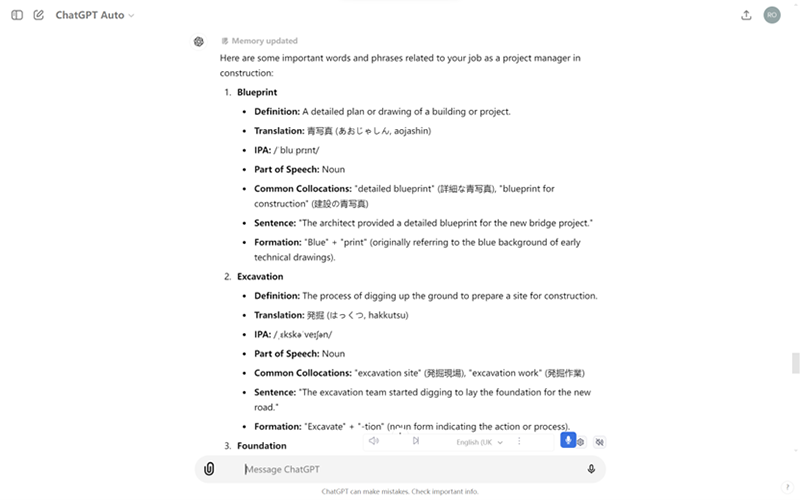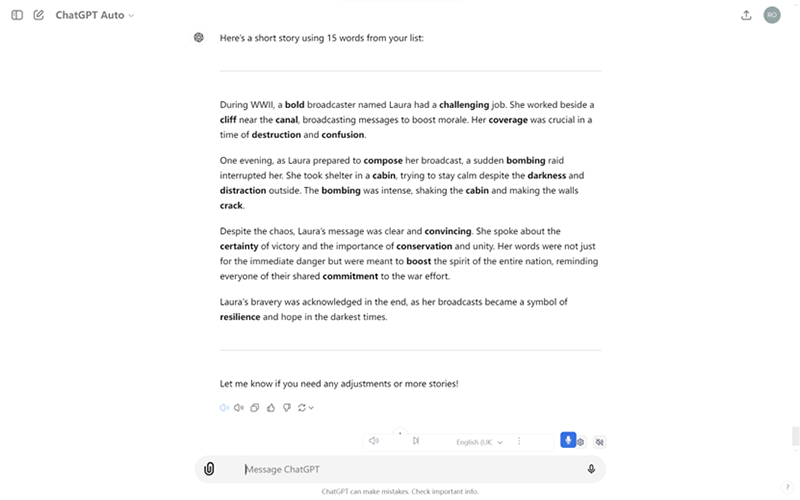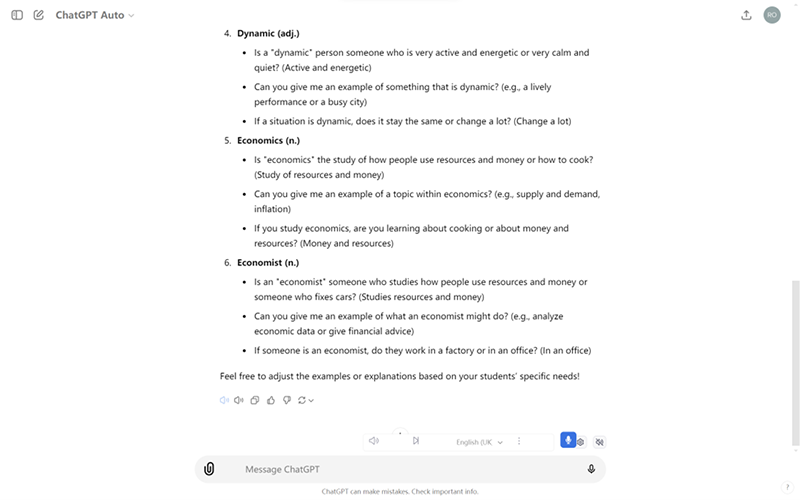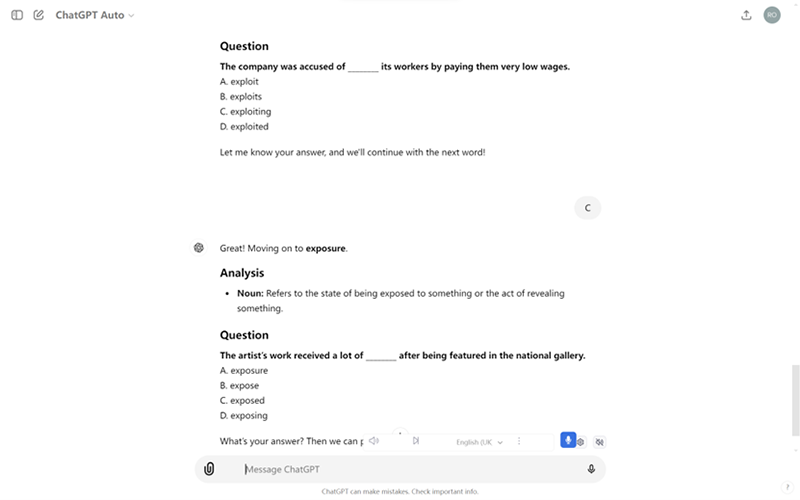18th November 2024
In this blog, we’ll look at how to use AI to help with vocabulary learning and teaching. So much of language learning is about learning vocabulary. Regardless of your students’ level, well-formed sentences mean nothing without the right words to fill them.
For better or worse, vocabulary is often taught in the order, present, practice, produce. For anyone who took a long nap around 1983 and just woke up, here's a refresher on PPP.
- In the presentation stage, the teacher introduces and checks the meaning of new vocabulary.
- In the practice stage, students do controlled activities. These help to reinforce understanding and correct use of the vocabulary.
- In the production stage, learners use the vocabulary to communicate something meaningful, possibly in a real-life situation.
We’re now going to look at how AI can help with vocabulary learning in each of the three ‘P’s.
Present
Presenting vocabulary involves a few steps. There’s choosing what vocabulary to teach. Then there’s presenting it in context (although, students don’t actually need to learn vocabulary in context in order to be able to use it). There’s also checking students understanding of what they’ve learned, by asking questions.
Personalised Vocabulary
There are three types of vocabulary that students need to learn.
- Common vocabulary. Everyone needs to learn ‘you’, ‘it’, and ‘thing’.
- Classroom vocabulary. If your students are learning English in a class, they’ll hear words like ‘speak’, ‘partner’, ‘whiteboard’ and ‘worksheet’ a lot. And if you teach in an online classroom, your student will hear words like ‘microphone’, ‘mute’ and ‘screen share’ all the time. Learning these words will help your students learn English in English.
- Vocabulary related to the students’ interests. This is the hardest vocabulary to teach. In most language classes, the students’ interests are different. Maybe you’re interested in learning about football, but my passion is mountain climbing. One student might work in HR while another works in marketing. I could work for an engineering firm, while you’re in the fashion industry. As a teacher (or coursebook writer) it’s difficult (or impossible) to help everyone learn vocabulary that’s relevant to them. This is where AI comes in.
Each student in your class can use AI to learn vocabulary related to their job, hobbies, next holiday, favorite cuisine, whatever! As preparation for class (or even as part of class), students can interact with an AI text generator to learn vocabulary to talk about themselves and their interests.
Prompt: I want you to teach me some important words and phrases which are related to my [job / hobby / interests]. [Description of what you need to do at work or with your hobby/interest]. Please write [number] words and phrases. For each word or phrase, please include:
- A definition (in simple English)
- A translation into [language]
- An International Phonetic Alphabet (IPA) transcription for the word to help with pronunciation.
- Part of speech (e.g. ‘noun’)
- Common collocations (words which often appear before or after this word) and a translation.
- A sentence with the word in it.
- Information about how the word is formed (e.g. suffix, prefix, etc.)

If students save their chat thread with the AI text generator, they can ask for more lexis in future or revise what they have already been taught.
In class, students can teach their classmates some of the most useful vocabulary that they’ve learned. Ask each learner to choose a handful of phrases which they think would be helpful for their classmates. Get the students to mingle with each other. Give learners one to two minutes to talk to a classmate and teach each other one or two words. Then ask students to move on to another classmate and teach a different word.
Teaching their classmates is a great way to help learners remember what they’ve learned. This activity will also help your students learn more about their classmates, improving your classroom dynamics.
Stories
Putting new vocabulary in stories is a great way to make it memorable. Each time students see a word it helps to strengthen their memory of that word. In the past, writing stories which include new language that students have learned was the responsibility of coursebook writers. Now teachers and even students can do this with the help of AI.
Give an AI text generator a list of recently studied words and ask the AI to randomly select some words and use these in a short text. The text can even relate to a topic that the learners are interested in.
Prompt: Select [number] words from the list below. Use to write a short story. The story can relate to [topics]. You must use the words accurately and appropriately. Using the words accurately and appropriately is more important than sticking to the topic. Word limit: [number] to [number] words. List: ### [vocabulary list].

Concept Checking Questions
An important part of teaching new vocabulary is checking the students have understood what you taught them. One common way of doing this is by asking concept checking questions (often called “CCQs”). Good CCQs can identify and correct misunderstandings students have about a word or phrase. Concept checking questions can be challenging to write. AI isn’t necessarily any better at writing CCQs than you or I, but it can save us time and give a different perspective. The prompt below includes some of the key aspects of effective CCQs. Add bullet points to the prompt below to incorporate your own CCQ best practices.
Prompt: I will teach some vocabulary in an English as a foreign language lesson. The students are [CEFR] level. The topic of the class is [topic]. The following vocabulary will be in the lesson. I want you to write [number] concept checking questions per word which I can ask to check students’ understanding of these words and phrases. Keep the following in mind when you write the concept checking questions:
- Be Clear and Simple: Use straightforward language to ensure the question is easy to understand.
- Focus on Key Concepts: Ask questions that target the main idea or concept you’re checking.
- Use Yes/No Questions: For example, “Is a ‘diverse’ group made up of similar people?”
- Ask for Examples: This helps confirm whether students can apply the concept. For example, “Can you give me an example of a diverse group?”
- Check Understanding in Context: Relate questions to the context in which the concept is used. For instance, for “distract,” you might ask a student, “What might distract you while studying?”
- Personalise: Ask open ended questions, where learners can personalise their answers. For example, if teaching “dull”, you could ask “What famous TV shows do you think are dull?”

The prompt above could also be adapted and used by students when learning new words themselves.
Prompt: I am learning English as foreign language. I recently learned some new words and phrases. I want you to ask me at least [number] concept checking questions per word to check my understanding of the vocabulary. Keep the following in mind when you write the questions:
- Be Clear and Simple: Use straightforward language to ensure the question is easy for me to understand.
- Focus on Key Concepts: Ask questions that target the main idea or concept you’re checking.
- Use Yes/No Questions: For example, “Is a ‘diverse’ group made up of similar people?”
- Ask for Examples: This helps check that I can apply the concept. For example, “Can you give me an example of a diverse group?”
- Check Understanding in Context: Relate questions to the context in which the concept is used. For instance, if teaching “distract,” you might ask me, “What might distract you while studying?
- Personalise: Ask me some open-ended questions, where I can personalise my answer. For example, if teaching “dull”, you could ask me, “What famous TV shows do you think are dull?”
- Ask me the questions one by one. After each answer, comment on whether I got the question right or wrong. If wrong, tell me what I misunderstood about the word.

Practice
There’s a lot more to knowing a word than just memorizing the dictionary definition. In this section we’re going to look at ways AI can help students practice vocabulary before (or after) using it to communicate. This kind of practice boosts students’ confidence and helps them to speak or write more accurately. Accuracy practice sometimes gets bad press as a poor use of class time. But with AI writing, and administering the questions and giving feedback on the answers, accuracy practice can happen before or after class (or during, if you prefer). This leaves more class time for communication, interaction and feedback.
Retrieval Practice
A lot of vocabulary learning is about memorization. Recalling words that you’ve learned recently will help you remember them better in the future. This process, if it works, should move lexis from students’ short term to long term memory. But how?
Traditional methods using flashcards are an effective way of doing this. Imagine picking up a flashcard with a picture or word in your L1 and trying to remember the English word on the reverse. Or you could look at the English word and try to remember the translation. Or you could see a simple definition of the word in English, then try to remember the word. These methods, although effective, require time and organization – traits that not all learners are blessed with.
The less organised among your students can ask AI to do the quizzing on their behalf. Let’s look at some examples.
Imagine that last week we taught our students some new vocabulary. You want them to memorise these at home. Arming students with a prompt can make this easier.
Prompt: I want you to play a language game with me. The aim of the game is to help me better remember new words that I’ve learned recently. I will show you a list of words. You need to choose one word on the list and give me clues to help me guess the word. The clues could describe the meaning, you can translate the word into my first language, [your mother tongue], or give a sentence with the new word missing. Keep giving me more clues until I guess correctly. Give the clues one at a time. Do not give me all the clues at the same time. Do not give clues related to the spelling of the word, such as “This word begins with… or ends with…”
Alternatively, be more specific and give the AI a list of examples of how to help students guess the words.
Prompt: I want you to play a language game with me. The aim of the game is to help me better remember new words that I’ve learned recently. I will show you a list of words. You need to choose one word on the list and give me clues to help me guess the word by showing me:
- a sentence with the whole word missing. E.g. “”
- 2-5 common collocations with this word (without showing the word).
- a translation of the word into my first language.
- a synonym or an antonym for this word.
- a sentence with half of the letters in the word missing.
- a simple definition (in English) of the word.
- a choice of 5 words, one of which is the correct answer.
Give the clues one at a time. Do not give me all the clues at the same time. Do not give clues related to the spelling of the word, such as “This word begins with… or ends with…” Do not show me the word or include the word in any of the clues.
These prompts let students practice new vocabulary on the bus/subway home from class. And if your students save their chat threads with the AI text generator, they can ask the AI to include vocabulary from previous prompts to help them revise.
Accuracy Practice
One of my favorite classroom activities is to listen to students as they communicate and note some of the mistakes they make. After the activity ends, the students look at their mistakes (on the board or on a slide) and try to correct them. The prompt below recreates this, asking an AI to imagine misuses of words you want your students to practice. Students then decide which of these are right and which are wrong.
Prompt: I need sentences for the following words: [list of words]. For each word, please create five sentences:
- Four sentences that use the word correctly in different contexts.
- One sentence that misuses the word.
For the misuse sentence, consider likely ELF student errors such as:
- Using the word in the wrong context
- Incorrect word form or syntax
- Misinterpreting the word’s meaning
The misuse must be clearly and objectively ‘wrong’. Do not indicate which sentence is incorrect. The misuse can occur in any position (1-5). The sentences should be appropriate for [CEFR level] students.
Word Forms
Another important aspect of learning new words is choosing the right word form for the right situation. (Think, “I’m so boring in my math class” or “Teacher, you are so humor!”.) AI can help by creating practice activities for class, or by helping students to practice outside of class. An AI text generator can challenge students to choose the right form for a specific sentence.
Prompt: I will show you a list of words. First, please analyse each word for its possible forms (e.g., noun, verb, adjective, adverb). After that, create multiple-choice questions, one at a time, where each question uses one of the word forms in a natural sentence with a blank to fill in. Use simple/high-frequency vocabulary for the rest of the sentence. Do not ask all the questions at once. Provide the analysis and questions one by one. Example question: ### That movie was terrible. I was so ________.” A. bore B. boring C. bored D. boredom.

Production
Language is mostly used for communication. Production activities help students to express ideas, opinions, and emotions clearly. Good production activities are meaningful and practical. They can push students out of their linguistic comfort zones, while building fluency and doing something memorable. But it can be difficult to think of production activities that match specific lexis. In this section we’ll look at how AI can help.
Speaking Activities
The prompt below can help you to generate ideas to practice speaking. Remember evaluate these and choose activities that you think would work for your learners.
Prompt: I want you to suggest ideas for EFL/ESL speaking activities which would encourage students to use the following vocabulary to communicate meaning: ### [vocabulary list]. ### These activities should…
- Encourage learners to work together
- Give the teacher opportunities to give learners constructive and corrective feedback
- Be relevant and interesting to my learners
- Include a clear context
- Require learners to use the vocabulary to achieve a specific communicative purpose.
- Include ideas for scaffolding, helping less proficient learners use the vocabulary
- Include ideas for extensions, challenging stronger or faster learners
### Please ask me questions, one at a time, until you have enough information to suggest relevant activities.
Writing Activities
The prompt below can be used to suggest writing activities that encourage students to use vocabulary to communicate in writing activities.
Prompt: I want you to suggest ideas for EFL writing activities which would encourage students to use the following vocabulary to communicate meaning: ### [vocabulary list]. ### These activities should…
- Encourage learners to write something to communicate meaning together
- Be relevant and interesting to my learners, mimicking real-world communicative contexts
- Give the teacher and other learners opportunities to give learners constructive and corrective feedback
- Include a clear context and purpose for communication
- Include ideas for scaffolding, helping less proficient learners
- Include ideas for extensions, challenging stronger or faster learners
Please include at least one of the following activity types (delete as appropriate): creative story writing, writing a memo to colleagues, report writing, descriptive writing games, writing a dialogue, an email/letter exchange roleplay.
### Please ask me questions, one at a time, until you have enough information to suggest relevant activities.
Conversation
Similar to reading a new word in a passage is hearing it in conversation. In some ways, hearing a new word in conversation is even better than reading it. The listener can ask the speaker to clarify what it means, or they even try using it themselves later in the discussion.
AI can be given a list of vocabulary and asked to use these (naturally) in a conversation with a student. This gives the student an opportunity to see it in context, process the meaning and attempt to respond appropriately.
Prompt: I want to practice using new vocabulary in a conversation. I’ll provide a list of words. Please roleplay being a [friend/colleague/other] and start a casual conversation with me on a general topic. Use only one word from the list per turn and keep each response to no more than two sentences. If I appear to misunderstand any of the words, briefly clarify their meaning. Feel free to adjust the topic of conversation as needed so that it fits the vocabulary.
Limitations
AI can save time by creating materials to practice vocabulary. It can facilitate vocabulary practice outside of class. But it can make mistakes. The more convoluted the prompt, the more likely it is that the language will sound unnatural or just be vanilla-favor wrong. This is particularly a problem when asking AI to generate stories with a vocabulary list.
Although AI makes mistakes, it isn’t good at making mistakes when you ask it to. Prompts asking AI to use language inaccurately don’t always result in sentences that you and I might think of as ‘wrong’.
These aren’t reasons to stop students using AI outside of class. Interactive, meaningful language practice with AI which includes a few mistakes is a lot better than no practice. But it does mean that it’s a good idea to check what students have learned while using AI outside of class. Ask students to share what they learned with a partner and share any areas of confusion (or learning) with the class. AI can also help in the checking process, by asking students CCQs about new words they have learned.
Conclusions
AI has the potential to significantly enhance vocabulary teaching and learning. It can assist teachers in preparing lessons, creating concept-checking questions and generating practice activities. For learners, AI can facilitate personalised vocabulary learning, support self-study, and provide interactive practice through games and quizzes. This doesn’t mean that AI needs to replace personal interactions, but it can be a great compliment.
Key Takeaways
- AI helps learners personalise vocabulary learning based on their jobs or interests.
- AI can generate custom dictionaries for learners to review and expand their vocabulary.
- Teachers can use AI to create activities where students practice and use new vocabulary.
- Concept checking questions (CCQs) ensure students understand new words. These can be created with AI.
- AI can help students practice lexis through games with AI that boost memorization.
- Teachers should check the accuracy of AI-generated materials and practice, as AI sometimes makes mistakes.



